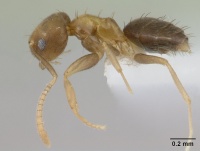Paraparatrechina umbranatis
| Paraparatrechina umbranatis | |
|---|---|

| |
| Scientific classification | |
| Kingdom: | Animalia |
| Phylum: | Arthropoda |
| Class: | Insecta |
| Order: | Hymenoptera |
| Family: | Formicidae |
| Subfamily: | Formicinae |
| Tribe: | Lasiini |
| Genus: | Paraparatrechina |
| Species: | P. umbranatis |
| Binomial name | |
| Paraparatrechina umbranatis LaPolla & Cheng, 2010 | |
Paraparatrechina umbranatis has been collected from a variety of forest habitats.
Identification
LaPolla et al. (2010) - Body distinctly bicolored, with gaster much darker than head and mesosoma.
Compare with: Paraparatrechina oreias and Paraparatrechina subtilis. This species is easily recognizable by the distinctly darker gaster (brown) contrasting with the yellow-brown head and mesosoma. While many Paraparatrechina species display various coloration patterns between the different tagmata this is the only species that could be considered truly bicolored.
Keys including this Species
Distribution
Latitudinal Distribution Pattern
Latitudinal Range: 0.6° to -11.485767°.
| North Temperate |
North Subtropical |
Tropical | South Subtropical |
South Temperate |
- Source: AntMaps
Distribution based on Regional Taxon Lists
Afrotropical Region: Angola, Gabon (type locality), Kenya, Rwanda, Uganda.
Distribution based on AntMaps
Distribution based on AntWeb specimens
Check data from AntWeb
Countries Occupied
| Number of countries occupied by this species based on AntWiki Regional Taxon Lists. In general, fewer countries occupied indicates a narrower range, while more countries indicates a more widespread species. |

|
Estimated Abundance
| Relative abundance based on number of AntMaps records per species (this species within the purple bar). Fewer records (to the left) indicates a less abundant/encountered species while more records (to the right) indicates more abundant/encountered species. |

|
Biology
Castes
Known only from the worker caste.
Nomenclature
The following information is derived from Barry Bolton's Online Catalogue of the Ants of the World.
- umbranatis. Paraparatrechina umbranatis LaPolla & Cheng, in LaPolla, Cheng & Fisher, 2010: 15, figs. 9,16,17 (w.) GABON.
Unless otherwise noted the text for the remainder of this section is reported from the publication that includes the original description.
Description
Worker
(n=12): TL: 1.19–1.57; HW: 0.34–0.36; HL: 0.38–0.41; EL: 0.098–0.112; SL: 0.38–0.43; PW: 0.21–0.27; WL: 0.42–0.49; PDH: 0.18–0.23; PrFL: 0.31–0.34; PrFW: 0.098–0.112; GL: 0.39–0.7. Indices: CI: 87–92; REL: 25–29; SI: 108–120; FI: 30–36.
Head yellowish-brown to light brown, with antennae mandibles, and medial area between antennae slightly lighter; head slightly longer than broad. A dense layer of fine, short, slightly decumbent pubescence covers head. Scapes surpass posterior margin by about the length of the first funicular segment; scape with a dense, slightly decumbent pubescence. Mesosoma yellowish-brown to light brown; fine pubescence covers entire mesosomal dorsum; lateral portions of the mesosoma are distinctly shinier than the dorsum. Pronotum rises steeply from anterior margin to dorsum. Propodeum possesses a short, angular dorsal face, with a long declivitous face. Legs generally lighter colored than mesosoma, becoming whitish towards last tarsal segments. Procoxae usually darker brown than meso/metacoxae; gaster conspicuously darker than head and mesosoma and is covered in a dense layer of pubescence.
Type Material
Holotype worker, GABON: Prov. Ogooue-Martime; Res. Monts Doudou; 24.5 km 303° WNW Doussala; 2°14.0’S, 10°23.9’E; 18.iii.2000; elev. 630 m (B.L. Fisher #2276) (California Academy of Sciences); 8 paratype workers, same locality as holotype (CASC, National Museum of Natural History).
Etymology
The species epithet is a Latin noun in apposition, a compound of umbra (=shade) and natis (=rump), in reference to the fact that the gaster is much darker in color than the head and mesosoma.
References
- LaPolla, J.S., Cheng, C.H. & Fisher, B.L. 2010. Taxonomic revision of the ant genus Paraparatrechina in the Afrotropical and Malagasy regions. Zootaxa. 2387: 1-27.
- Nsengimana, V., Hagenimana, T., Barakagwira, J., de Dieu Nsenganeza, J., Iradukunda, S. C., Majyambere, M., Kizungu, O. B., Nkundimana, A., Umutoni, D., Fabrice, R., Cyubahiro, B., Kouakou, L. M., Kolo, Y., Anale, J. S., Gómez, K., Dekoninck, W. 2023. Checklist of ant (Hymenoptera: Formicidae) species from Nyungwe Tropical Rain Forest, south-western Rwanda. Journal of East African Natural History 111(2), 69-81 (doi:10.2982/028.111.0203).
References based on Global Ant Biodiversity Informatics
- LaPolla J. S., C. H. Cheng, B. L. Fisher. 2010. Taxonomic revision of the ant (Hymenoptera: Formicidae) genus Paraparatrechina in the Afrotropical and Malagasy region. Zootaxa 2387: 1-27.
- Lapolla, J. S., C. H. Cheng, and B. L. Fisher. "Taxonomic revision of the ant (Hymenoptera: Formicidae) genus Paraparatrechina in the Afrotropical and Malagasy Regions." Zootaxa 2387 (2010): 1-27.
- Ross S. R. P. J., F. Hita Garcia, G. Fischer, and M. K. Peters. 2018. Selective logging intensity in an East African rain forest predicts reductions in ant diversity. Biotropica 1-11.

